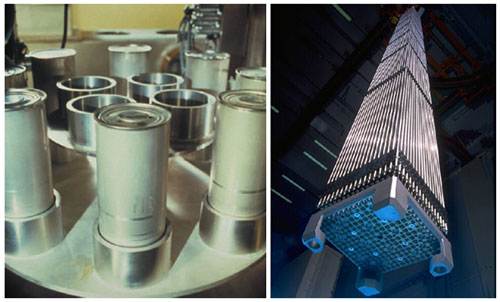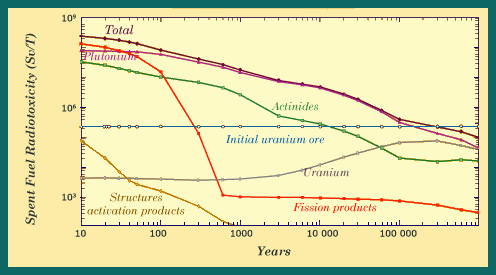Plutonium dark and bright sides …
Sensitive material, like the roman god Janus, plutonium has its dark and bright sides. The bright side are its remarkable energetic quailities. Plutonium is a first choice nuclear fuel. The dark-side are its remarkable quaiities for a atomic bomb. Weapon -grade plutonium is a first choice nuclear explosive. A second dark side is that plutonium is a radioelement known for its high radioactive toxicity, should it would be some day considered as a nuclear waste.
In order to use its energy potential, plutonium is extracted during the reprocessing of spent reactor fuels. It is then incorporated in a mixed fuel, MOX, and then loaded in reactor. In France, only the plutonium needed to fuel reactors burning MOX is separated and recycled. This avoids the need of storing the plutonium. After recycling in reactors, the MOX fuel still contains plutonium. The MOX spent fuel assemblies which are highly radioactive are stored in a pool in secure sites. Fast neutrons breeders reactors, would be neeeded to burn efficiently plutonium and reduce or stabilize the accumulated inventory of plutonium.

Reuse plutonium for MOX nuclear fuel
The plutonium coming out in France of the spent fuel reprocessing is reused to produce a fresh fuel made of uranium and plutonium oxides,, the MOX. On the left, the photograph shows a carousel of boxes containing plutonium. Plutonium is split into these small boxes to avoid the risk of criticality. On the right, a MOX fuel assembly manufactured in the Bagnols-sur-Cèze AREVA Melox plant in France. The assemblies containing plutonium are much more radioactive than those standard uranium fuel.
© AREVA
Reduce access to weapon-grade plutonium
The reduction of unwanted access to weapons-grade plutonium remains one main goal of nuclear non-proliferation. An atomic bomb fortunately request more than 90 % of fissile isotopes, much than the 60% fissile plutonium_239 and 241 coming out of power reactors. To increease the ratio of these fissile isotopes would require expensive and advanced technologies well over the means of rogue states or traffickers.
The most common pressurized water reactors (PWRs) and boiling water reactors (BWRs) are not prone to proliferation. During operation, the only time the plutonium has the weapon-grade quality is when the fuel is still fresh and the fissile isotope 239 has accumulated before the formation of the sterile plutonium-240. The plutonium collected 3 or 4 years later at the time of the fuel cunloading contains around 60% of fissile and 40% of non-fissile isotopes .
The most proliferating reactors are those whose fuel can be unloaded after a short period of operation, as in some research reactors, old Russian reactors, or those of CANDU technology. With surch early unloadings, North Korea, refusing to abide by any rule, managed in 2005 to extract from a small reactor enough weapon-grade p for its first atomic bomb.
Besides this extreme case, civilian power reactors are controlled by the International Atomic Energy Agency in countries that have signed the Nuclear Non-Proliferation Treaty (including Iran). The spent fuel reprocessing in France at the La Hague plant, the plutonium separation with the manufacture of MOX fuels, are also under the control of tthe same agency.

Evolution of spent fuel radiotoxicity
The evolution over time of the radiotoxicity of a spent fuel assembly shows that the contribution of plutonium becomes predominant after 30 or 40 years and for very long times. If not separated by a reprocessing, this plutonium contribution dominate the waste that will be stored. This lasting toxicity, the significant heat release explain in addition to its energetic potential why France has chosen to extract plutonium from nuclear spent fuels.
© CEA
A radiotoxic long-lived and calorific waste
The plutonium is about 10 times more abundant in spent fuel than minor actinides. Concerns about plutonium and minor actinides  geological disposal arise because these heavy nuclei are both chemical and radioactive poisons. The plutonium radioactivity comes mainly from isotopes whose half-life
geological disposal arise because these heavy nuclei are both chemical and radioactive poisons. The plutonium radioactivity comes mainly from isotopes whose half-life  is shorter than that of the fissionable isotope 239 (24110 years).
is shorter than that of the fissionable isotope 239 (24110 years).
Plutonium isotopes, which are llpha emitters except plutonium-24, are very radiotoxic in case of ingestion. Uptakes occur mote through the respiratory than the digestive tract. The fixation of plutonium has a biological half-life of about 20 years on the liver, of 50 years in the bones. However, one should remember that the plutonium shows very little mobility. Conditioned generally as insoluble oxide (PuO 2), it hardly enters the biosphere.
If spent fuels with their plutonium are to be stored as ultimate waste, they would require deep geological disposals, much larger and expensive that the one planned in France for vitrified package. In such geological facilities, the more heat is released by radioactive decays , the more spacing is needed to separate waste packages.
The plutonium alpha decays are about ten times more calorific than fission products beta decays. While the heat released by fission products, initially prevailing because of the caesium and strontium nuclei, will practically vanish within 300 years, the predominant plutonium-239 will take 24 000 years to be divided by two. Considered as waste, spent fuel assemblies would release more heat, much longer and would require more space.
Other articles on the subject « Nuclear Fuel »
Nuclear Fuel Cycle
The front-end and the back-end of the cycle… The nuclear fuel cycle includes all nuclear op[...]
Cycle Front End
From the extraction of uranium to the fuel fabrication The front-end of the nuclear cycle is the [...]
Isotopic Separation
The access key to the fuel of modern nuclear power plants … and to atomic weapons The uranium fue[...]
Ultracentrifugation
A separation process economical in energy, but proliferating The principle of centrifuges has lon[...]
Gaseous Diffusion
The first enrichment process, a large consumer of electricity The gaseous diffusion process was t[...]
PWR fuel assemblies
Fuel assemblies in the core of PWR Reactors The core of a pressurized water reactor (PWR) is cont[...]
Reactor fuel layout
Fuel assemblies in the core of nuclear reactors The nuclear fuel assemblies, that vary from one r[...]
Plutonium Use
A fissile element produced in nuclear reactors In February 1941 the American physicist Glenn Seab[...]
MOX fuels
Introducing plutonium in nuclear fuels For energy production, plutonum is gold ! One gram of plut[...]
Thorium Fuels
Uranium 233: a fissile nucleus made from thorium Thorium is more abundant than uranium in the Ear[...]